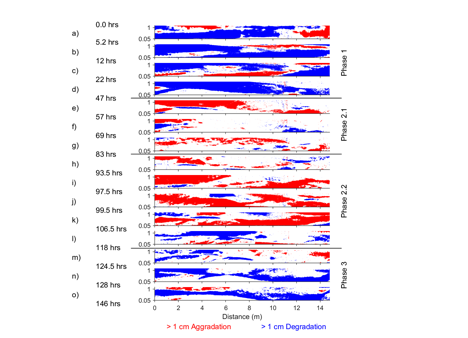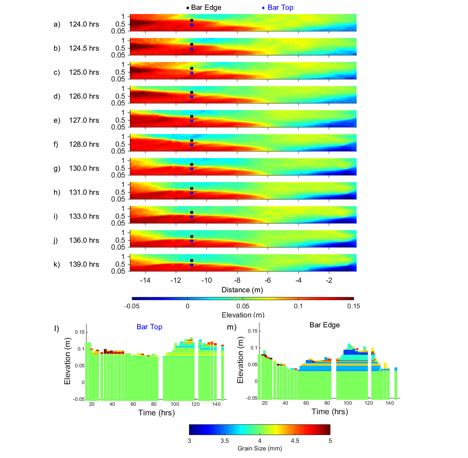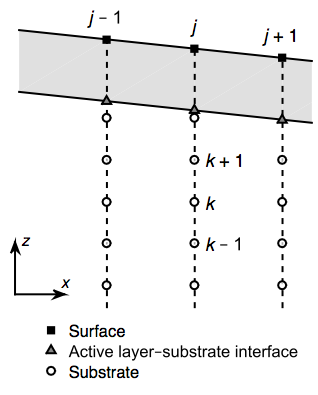Reports: DNI853837-DNI8: Modeling Stratigraphic Feedbacks in Fluvial Morphodynamics
Peter A. Nelson, PhD, Colorado State University
Introduction
Under conditions where channel aggradation is followed by degradation, a river will create and then consume its own stratigraphy, and we do not yet have a quantitative or predictive understanding of how this may affect bar dynamics. The goal of this project is to use physical experiments and numerical modeling to explore feedbacks between the creation and consumption of stratigraphy and the morphodynamics of rivers with gravel/sand beds.
Summary of research activity
Flume experiments
We conducted experiments at the Colorado State University Engineering Research Center hydraulics laboratory in a 1.2 m wide, 18.3 m long, 0.76 m deep rectangular flume. The overall goal of the experiments was to investigate bar dynamics in response to a cycle of aggradation and degradation by first developing alternate bars in heterogeneous sediment under an equilibrium sediment supply, then increasing the sediment supply so that the bed would aggrade and develop stratigraphy, and then decreasing the sediment supply to the initial condition to induce degradation.
During the aggradational phase of the experiment, the channel aggraded in the pools which caused the shear stress at the bar edges to increase and led to some lateral erosion of the stable bars (Figure 1). The first supply increase was not sufficient enough to mobilize the entire bed, but a second, higher, supply increase led to aggradation in the pools that increased the shear stress over the existing bars enough to effectively rework the entire bed. This suggests that a threshold sediment supply increase exists that must be overcome in order to promote bar migration. As the entire bed aggraded during high-supply conditions, the channel developed a non-uniform stratigraphy which we quantified with subsurface measurements and modeled based on topographic and surface grain size measurements. Both the measurements and model showed a coarse subsurface under much of the upstream bar, but predicted a finer layer of sediment in the subsurface at the bar edge (Figure 2). During the degradation phase, the pools incised following the supply reduction which led to lateral erosion of the stable bars. This lateral erosion was largely limited to areas underlain by finer sediment, and erosion ceased when the coarse substrate deposited during the earlier bar-building phase became exposed. This suggests that patterns of subsurface grain size are an important control on channel evolution during degradation.
Figure 1. Areas of aggradation (red) and degradation (blue) of more than 1 cm between times bounding the left side of each map. The horizontal lines between runs delineate the different phases. Flow was from left to right.
Figure 2. Top: ((a) - (k)) Bed elevation during Phase 3. The black dots indicate two locations on the x = 4 m cross section, one on the bar edge that was laterally eroded (y = 0.76 m) and another that was not eroded on the same bar (y = 0.46 m). Bottom: Temporal evolution of the vertical distribution of subsurface sediment D50 predicted with the simple stratigraphy model (l) on the bar top (y = 0.46 m) and (m) at the bar edge (y = 0.76 m) with Phase 3 represented by a dashed box.
We found that patterns of local critical shear stress play an important role in determining whether bars persist or disappear after a supply reduction. In our experiment, bars persisted during the supply reduction because the shallow flows over the coarse grains of the bar tops produced boundary shear stresses below the critical value for entrainment. As the pools degraded in our experiment, the local boundary shear stresses at the bar edges increased sufficiently to mobilize the surface grains exposing finer grains in the subsurface. This fine grain size decreased the local critical shear stress, allowing for further erosion until the coarse subsurface was reached and the critical stress exceeded the local boundary shear stress.
Morphodynamic model
The second major component of this project involves the incorporating a stratigraphy submodel into a two-dimensional morphodynamic model. We have generalized the one-dimensional stratigraphy model described by Viparelli et al. (2010) for use in a two-dimensional framework, and implemented this model in FaSTMECH (Flow and Sediment Transport with Morphological Evolution of Channels). FaSTMECH was recently modified by Nelson et al. (2015) to handle multiple grain size sediment transport and bed evolution.
After many exploratory calculations, we are now confident that the new stratigraphy submodel is performing calculations correctly. Figure 3 shows the general scheme used for storing grain-size information in the subsurface. We are presently using the conditions of the flume experiment, described above, to test the accuracy of the model and to compare model results with and without stored stratigraphy.
Figure 3. Nodes of grain-size distribution storage for the stratigraphy model, for a single cross-stream coordinate. The shaded region corresponds to the active layer.
Research impacts
Our flume experiments are the first to explicitly explore the connection between stratigraphy, sediment supply, and channel morphology, and our experimental findings have pointed to the importance of accounting for surface-subsurface sediment interactions during periods of aggradation and degradation. The stratigraphy submodel for FaSTMECH that we have developed will be incorporated into the iRIC (International River Interface Cooperative) modeling interface, making it freely available to other researchers.
This project has supported two graduate students and several undergraduate students, allowing them to obtain valuable research experience which will serve them well as they go onto their careers in academia or industry. The project has also helped establish the river morphodynamics research group at Colorado State University, providing the resources and motivation further our ability to conduct physical and numerical models of important earth surface processes.
References
Nelson, PA, RR McDonald, JM Nelson, and WE Dietrich, 2015, Coevolution of bed surface patchiness and channel morphology: 1. Mechanisms of forced patch formation. Journal of Geophysical Research: Earth Surface, doi: 10.1002/2014JF003428.
Viparelli, E, OE Sequeiros, A Cantelli, PR Wilcock, and G Parker, 2010, River morphodynamics with creation/consumption of grain size stratigraphy 2: numerical model, Journal of Hydraulic Research, 48, 727-741.














